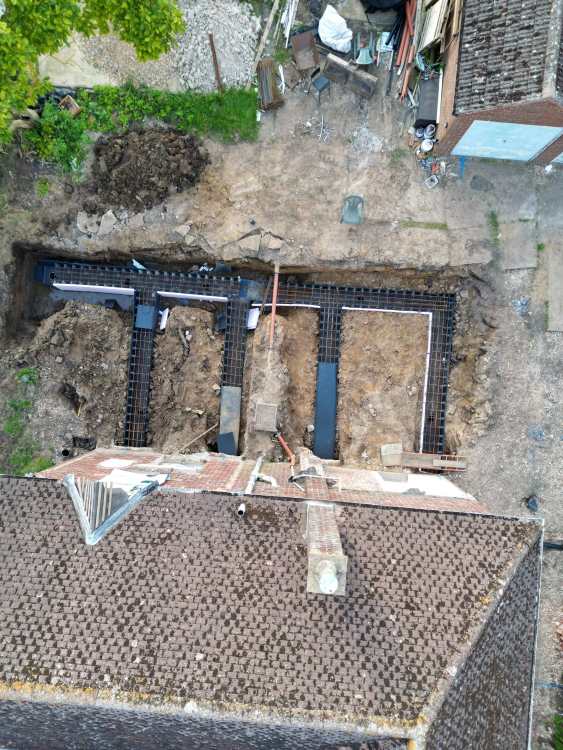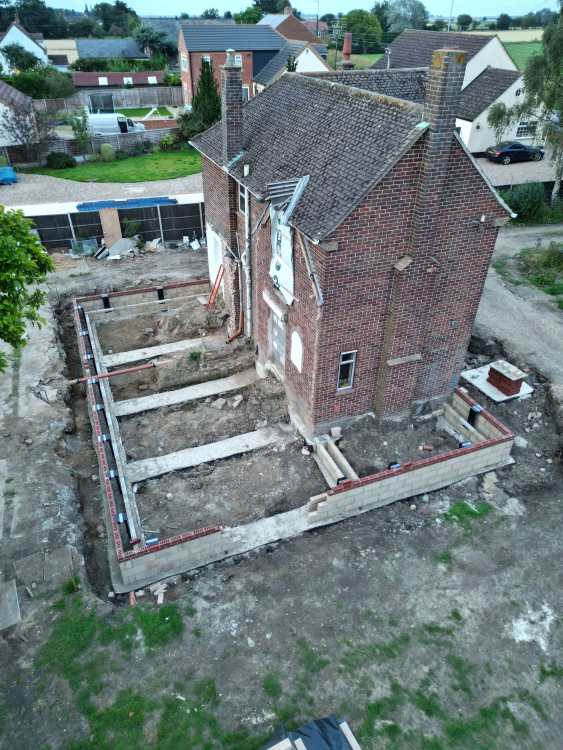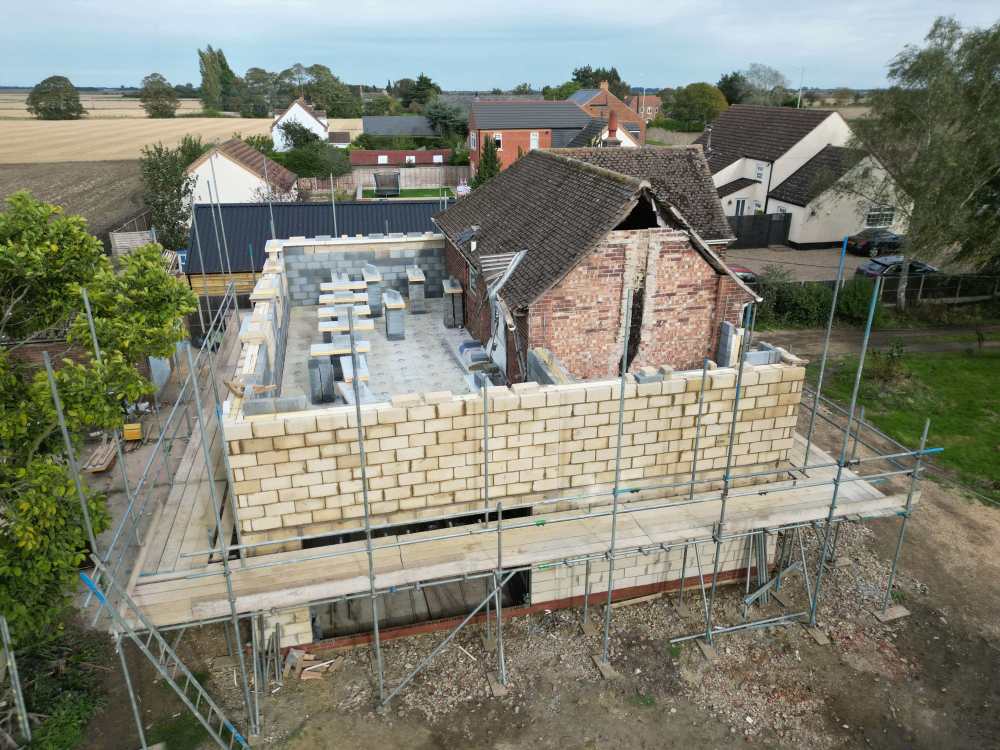Leaderboard
Popular Content
Showing content with the highest reputation on 11/20/24 in all areas
-
I’ve been meaning to put up a thread on that subject for ages. OK here:3 points
-
This is a useful skill - particularly if you’re making a big payment in advance or there’s a long delay between making a payment and receiving the goods or services. Also check out the various threads on getting credit and delivery protection by using credit cards.2 points
-
I return... nearly 18 months later. The project is still ongoing, but I thought it was worth updating everyone on our experiences so far. I admit we've probably made a few mistakes but as a first attempt at a big project I'm pretty happy how we've dealt with issues and moved on; every day is a school day! If any of this helps anyone else then it's worth it even if I look a bit daft during it! So - onto the project. We started by demolishing the old extensions since the foundations for them wouldn't be up to supporting a floor above them, plus they were built inadequately for our needs (solid walls, weird floor buildups, even weirder roofs). There was plenty of advice on this site around the existing foundations and how to proceed with them which we really appreciated, but in the end we were led by the structural engineers and underpinned the property for peace of mind to avoid any differential movement. The extension foundations are piled down to about 8-9m and the existing property was cantilever underpinned using piles too. Overall we're pretty confident the house won't be going anywhere (we now have 36 piles!) We've then wrapped a fair chunk of the house in a new extension to better use the space, and put the poorer performing old external walls further into the property. Cavity is 200mm with 190mm PIR made up in two layers incl interlocking boards and tape, and the flooring is 240mm EPS insulation in the new areas, whilst we've just finished digging the old flooring out of the house which should be insulated to 170mm. I'd like more here but we're restricted by the depth of existing foundations which is a shame. The old electricity supply has gone from overhead to a nice new underground supply, complete with 3ph up to the DNO supply head so we're future-proofed (still only 1ph currently) and I'm waiting for a response to my request for a new water supply. Wet UFH is throughout, with the oil boiler gone and an ASHP to replace it (When I can get an installer on the BUS grant that won't rinse me). Spent a fair bit of time playing with Heatpunk and Jeremy's spreadsheet for heat loss predictions which is fun when half the property is 200mm cavity and the other is 50mm. I really wish here that we'd stepped the walls outwards and then EWI'd the older walls but I didn't think about this until it was too late - a good reminder to plan ahead here. I'm also scheming for 10kWp of PV to go on since we're having a new roof fitted. The savings in tiles & labour lets me man-maths my way into some GSE trays and panels 😁 My current focus is looking at the air tightness, not as much of an issue in the new section but the older part of the house is good fun, so I guess there will be updates on this part from time to time as I'd love to get MVHR fitted as well. Words can be boring sometimes, so the tl;dr is: should we have listened to you all knocked it all down and started from scratch? In hindsight, Yes 😂 Did we? No... (Be gentle 😳) time to learn from it and make the best of it! And the pictures: Steel reinforcement for ringbeams in place after piling at the back Starting the build to DPC Second lift and on the way to wall plate. Will maybe dump a few more before & after shots in the coming days or a specific focus on parts if anyone is interested. Poor house has been battered about a bit - for the greater good I hope!2 points
-
That's what I've read, and I do hope so. I'm going to try to lime plaster the window revels in a 600mm thick stone wall. If I get on alright with that, I'll try larger areas. I find it very tricky plastering with gypsum and get on better rendering with cement.2 points
-
Build the opening smaller then, stick to around 5m. having built two new houses and multiple renovations with this type of extension on the back I can’t think of a reason for such a big door. we where going to have two sets of 5m wide doors in the back, but went for one and a picture window, and our view out the back is probably better than 95% of peoples, we just couldn’t see it being used fully, and the impracticalities were many. A 6.5m wide opening looks good on the fancy architects plans. but that is all. pros and cons of such a big opening. CONS. future deflection effects door working properly Expensive steel more calculations very expensive door problems with such a door in the future how many days in England will you actually want it fully open smaller reveals on the inside restricts furniture and kitchen layout. PROS. You can show your friends what a big door you have.2 points
-
I use companies house to check out directors how often they start up new businesses and then close them down again within a few years. Companies house will mark up when a strike off on the gazette is updated this is the first stage to a business not filing accounts or a creditor pushing for liquidation etc. I look at the accounts and see how many they employ, gives you an idea of permanent employees or subcontractors used. The capital retained rather than fully drawn out as dividends, but that might depend on size of business, personally I always take dividends after closing accounts. Check the total debtors and creditors balances. Investing in the company in assets. If you’re not sure of how to read accounts get a credit check on them, try https://www.companysearchesmadesimple.com you can pay per company search or a subscription for a month then cancel.2 points
-
Hi, im looking at self installing an MVHR system into my house, it is a 3 bedroom detached house with 1 kitchen and 1 bathroom roughly 130sqm, early next year we will be adding a side extension which will add 1 utility room, 1 bathroom and an office which will take the house to 170sqm. the unit will be placed in the loft which is boarded out and well insulated and i have a good idea where the ducting can run to be able to reach each room. i am wanting to do the design calculations myself to select the best unit and correct size ducting and looking for a good spreadsheet to start off with, i thought this forum would be the best place to start, thanks1 point
-
Getting towards the end of my build and I've been reflecting on what I would have done differently if I started again. For me, the biggest obstacle during building was the weather. The rain was incessant - there was barely a full day without at least some rain. This caused big delays as the constant stopping of brickwork caused knock-on effects of other scheduled work. As an example, we had a window production slot booked but they wanted the 'as-built' measurements of the openings, but the brickwork couldn't be finished in time so we missed the slot and got put to the back of the queue. I would say an extra 6 months got added onto the build because of the weather. If I was building again, the number 1 thing I'd do differently is fork out for the cost of a temporary scaffolding roof right at the start. I didn't even consider it originally due to the cost (c£15k) but if it could have allowed us to ignore the rain then it would have paid for itself several times over. I'm curious what others would do differently after they've got the experience of their first house build under them?1 point
-
A parge coat is used to make the wall airtight, for three reasons. First, it stops stop cold outside air from reaching the insulation, which would degrade the effectiveness of the insulation and potentially lower the temperature within the insulation to the point where condensation forms - which is why it needs to be on the outside of the insulation. Second, it stops the wind from blowing outside air in and drawing inside air out. Thirdly, it stops air escaping due to the 'stack effect' - that is, even on a day without wind, warm moist internal air is more buoyant than the outside air, so will rise and escape through any gaps, drawing outside air in as it does so. If the building is airtight, the air pressure inside the house and inside the insulation will be more-or-less identical, so there's nothing to drive that warm moisture laden into the insulation. So, in answer to your question, no, it won't. That leaves only differentials in relative humidity as the means by which moisture (moisture vapour) can move through the materials and into / out of the insulation. Which is why, if one has been specified, a vapour control layer will always be on the the warm side of the insulation (or at least not more than 1/3 of the way into the insulation, according to a well-known rule of thumb).1 point
-
Well it's the second day on week 4. The ground floor screeding is being done as I type this. To date all the walls are up (they come fully glazed, partially rendered and plasterboarded). The roof has been tiled and guttering fixed, the first fix electrics are done, the first fix plumbing is done (wastes and supplies for basins, wc's etc come ready installed in the panels), the underfloor heating is in and the MVHR ducting in place. In the service room is the cylinder, expansion vessel etc for the ASHP and the external unit is here wrapped, sitting on it's pallet. They started on the 8th April and expect to hand over at the end of May. We elected to use Dan Wood as a "half way house" - it's our original design (although with a nod to that sort of style). We didn't go extreme, much as we would like as I wanted a smooth planning experience, which we got. So, some of the standard Dan Wood bits we omitted. They can finish right up to carpets; handing over complete, save for the kitchen (too many choices apparently). We wanted a UK stair with closed risers so it could be carpeted. DW use bare wood, open riser and being aimed at the German market, the pitch is lower so the going messed up our internals too much. We also left out the doors (odd looking with the leaf rebated and closing against the face of the frame) and floor finishes save for the bathrooms. Those are now down to us. We had to provide the foundation (insulated raft for us) and drainage/service connections. However, it's been a dream not having to organise anything once they sign off the slab as ok. Men turn up at 7.00am sharp and work to between 5 and 6. Saturdays 8 till 1 ish. All materials are either brought with them or turn up on time. Electricians, plumbers, and scaffolders are woven into the work and are here at the correct point. The electrician was here until 11pm finishing off first fix because the next trade needed it done. Every single day it progresses. It probably isn't the cheapest way of doing it ( about £1730/m2 ex foundations) but the joy of not having any arguements with individual contractors makes up for it and there is no doubt the polish crew working on this house work damm hard and do a good job. You have to credit their attention to detail too. They obviously do this all the time as all the membranes are properly taped and sealed, the windows being inserted in the factory are done properly, etc etc. It's clear they have designed out issues over the years and have come up with solutions that work - hence the 20 year guarantee. We could buy the plot but needed to sell our house to fund the build. We are in a static caravan at present on site. Having reached retirement the certainty of getting the build done in a sensible timescale so we could get on with enjoying life was a big driver for this approach. Hopefully it'll be a family Christmas settled into a house this year instead of renting a cottage to escape the cold and damp of a 32ft static!1 point
-
It would likely be much cheaper to use your local authority's pre-app service compared to the £1,000 appraisal1 point
-
1 point
-
I can't help with that system, but: Condensation should only form on the exhaust ("to atmosphere") side. In winter, warm moist air from the house is being chilled by the incoming air, so the air will no longer be able to hold as much water, causing condensation if the temperature drops enough. If a unit isn't built with good enough insulation between the supply and exhaust sides, or if it allows air to leak from one side to the other to any great extent, then theoretically condensation could form on the wrong side. I've not heard of that happening though, and it would be surprising if that happened only after 3 years of use. Unless the heat exchanger has been removed and hasn't been seated correctly afterwards? You definitely don't want two drainage points; that would be a route for air to leak between the intake and the exhaust.1 point
-
I’m having a similar problem with one of my in-line fans. It was noisy from day one so the plumber turned the power down. It still passed the ventilation test but since then got louder and louder then silent apart from the sound of trickling water. He’s just been up in the loft to inspect and drained some water out and turned it back up a notch. It sounds fine at the moment but ( while it’s still under guarantee) he’s going to order a replacement and switch them over. There is a very slight rise (about 10 mm in 250 mm) from the extractor to the condense trap but he thinks this won’t be the cause of the problem. When he installs the replacement he will raise it up anyway.1 point
-
After removing the old heating system a couple of weeks ago, the engineers arrived at 10am Monday morning last week - waiting for the delivery of all the 'bits'! We'd installed a couple of electric oil filled radiators for mum and dad and luckily the weekend was mild. The lorry arrived around 11am, things were unloaded and taken into the back garden, then the guys all disappeared to go and get the pipework..... So after lunch, back the 2 chaps came and installed the ASHP into the back garden, with pipes into the roofspace. (one lives in Stamford, 2.5 hrs drive from here! - no wonder it took a while for them to arrive.) Tuesday, we had 3 guys, ftting the radiators into the place. I was told the electricians would be there thursday and friday to connect everything up. Wednesday 3 guys again, all sorted of things were now fitted into the cupboard and the radiator installations continued. There were 2 under bench blowers in the kitchen as there are no walls for a radiator. They were fitted but not connected - needed an electrician. Two radiators had to be removed and replaced as they had faulty paintwork (nice to know they arranged that themselves, we didnt have to complain). Not sure what happened thursday but no electricians turned up. 🙁 Friday, 2 electricians arrived and started to connect the system. But then one said they had to leave at lunchtime! I was not impressed but to be fair, they carried on, until the system was up and running. I had a quick explanation and off they went, around 2pm. The house was lovely and warm with hot radiators! Yippee. 😁 Saturday as I drove to a friends many miles away, we had a call from the parents - they had no heating! Grrr. But after emailing the 'boss' - within an hour, he arrived at the house and sorted out the problem - air in the system. Heating resumed. 😄 Sunday - Mums 85th birthday. House toasty and all happy. 😁 Dad mentioned a problem with his bathroom radiator which was so cose to the door that it could only be opened half way. email sent to 'boss' who arranged for an engineer to come MOnday. Which he did (from Stamford), he moved the radiator (cursing the idiot who placed it there) and fixed the fronts onto the under bench heaters. All looking good. Tuesday - unknown to me (they didnt tell me), there was no heating again and the 'boss' was called by Dad. He arrived after an hour and got it working again, telling them it was all sorted. But today, wednesday, when I arrived at 9am, the house was cold. Arghhhh!!! After emailing the 'boss' who arranged for his business partner (the elctrician from last week) to ring and come out. In the cupboard, the box which seemed to talk to the thermostat was flashing amber - and not sure that was right, i pressed a button and it turned flashing green. But still no heat after half an hour. I then found a manual online for the thermostat - Drayton Digistat - from which i discovered it had been set to a particular schedule for those out at work all day - ie on for a couple of house in the morning, low during the day, warmer for the evening and off at night! Not ideal for two 85yr olds, at home all day. After installing the app on the tablet - didnt work - and then on my phone, i was albe to amend the temperatures up to 21oC from 6.30am to 22.00pm with 16oC at night. I could see the Digistat registering that change and start the heating symbol. but the radiators stayed cold and the temperature did not change from 17oC. The electrician rang and I told him about the flashing light. I was told to press it till it was constant green which we did. And then i heard the pump start and water could be heard moving. But still no heat. After a couple of hours, he arrived and confirmed that while the App was controling the Digistat, they were not talking to the bix in the cupboard. After some work and a call to the Manufacturers, he re-set the system and everything seemed to be talking to each other. I was able to boost the temperature with the App and the house started to warm up. So thats the current situation - its taken several visits and several days without heating but fingers crossed, it continues to work. When it does work, the place is toasty, and I have to admit that all the guys have been great with mum and dad, moving out the way when needed, and being polite/helpful. And the 'boss' and Electrician have been quick to come out and try to fix the problem. I just hope there are no more calls. Will update in a few days.1 point
-
I think we all know how much we can trust Kingspan datasheets. 🔥1 point
-
Brilliant! Thanks Alan. (Should be a pinned thread maybe?)1 point
-
Can I make a couple of comments 1. You make very nice spreadsheets that are really easy to follow and incredibly useful as a resource - thank you 2. I'm very sure all of my rads are oversized 😉 but your spreadsheet has made me actually think about how oversized mine are (I did the heat loss calcs a while back and when I've finished my loft insulation project I'll do the whole thing again to correct for the changes). I will probably help my understanding if I go and work it all out room by room. I'm not about to change rads for even bigger ones - that would probably be an expense for little gain (or a stupidly long payback) I'm already operating the boiler on CH in condensing mode all the time the returns on reducing flow temps further might be fairly damn small.1 point
-
I've duplicated some of this story in my separate trench blocks thread. Thanks for all the responses here. The work continues. I have plenty of sympathy for the builder. He is working hard in conditions that are more difficult than we anticipated. I agree, the ground is eating my budget, & the BCO has cost me a fortune by telling me to pay for something to be done then telling me, on his next visit, that what he asked me to do (& I've paid for) is not what needed to be done, & a new plan needs to be devised & paid for. My email to the builder was not dictatorial; I set out some materials calculations & asked him to comment on them or correct them. I was seeking clarity on how much of what I'd paid £17,000+ for had been done & how much had not been done - ie how much of the £17k+ should have been deducted from the subsequent invoice I received, which covered implementing the new plan that was required because the BCO didn't tell us he was concerned about the tree, on his first visit. The new plan replaced the £17k plan - it wasn't a case of, "Do everything I told you to do & do this extra work as well.". I'm more inclined to agree with Joe's view, "get it in writing", than pay for an off site meeting during which the builder must attempt to explain loads & loads of figures & a fair amount of maths. There's too much to take in if I'm listening to it all, rather than steadily working through an email I've printed out & can write notes on. We've had a good meeting since our email exchange.1 point
-
I'm not sure I should admit this but that is pretty much what I've got! Specifically, a Reolink Doorbell with AI person detection that triggers a Shelly smart relay to turn the porch light on. It was born out of an overreaction of being annoyed by the PIR sensor triggering in the wind! Overkill, yes, but it works ridiculously well.1 point
-
If you just installed fan coils you could run a fixed flow temp of 30 to 35, depending size of fan coil.1 point
-
You can get a copy of the Land Registry documents for your land/property for about £3 (last time I did it). That might answer some questions. Also, worthwhile setting up a Land Registry Alert on their system. That way, if anyone tries to put a charge on your property or land you will be informed and can stop them.1 point
-
Personally I won't do anything. When selling our old house, that was still listed on the paper registry not on line so as soon as I informed our solicitor that we were going to sell it, he put in place the transfer to the electronic registry so it was all ready and would not cause delays. Should we ever decide to sell this one, we will do the same, make any changes at the time we are selling.1 point
-
1 point
-
Spoke with the Scottish Land Registry. Obviously this relates to Scotland so the information might not relate to England. 1. The land registry only particularly cares about the land so it doesn’t matter to them necessarily what subsequently gets built on it. 2. It is possible to change the entry for the title to update it with the new address. You can do this via their online portal link below. You need to provide evidence (council tax bill showing new address) It’s a free service but will take some time. https://scotlis.ros.gov.uk/title-enquiry 3. There’s no guarantee the rectification team will make the change however. Ordinarily any changes are done at the point a title is changing ownership so old title says this new title should that. 4. Title inaccuracies can cause delays when applying for a new mortgage or hold up a sale. It can take weeks to resolve so making a request to rectify before you really need to do so can stop these delays. Clearly depends on your circumstances. No mortgage or plans to sell in the immediate future then no need to change anything. We had exactly this issue with the sale of our previous house. Caused weeks of delay. Eventually only sorted because I phoned the land registry myself, explained the situation and the very helpful lady made the change while I was on the phone.1 point
-
The bigger companies will also have a Profit & Loss statement or P&L. The smaller ones won’t. If there is one, just observe (in the last line of the statement) whether the company is making a profit or loss and whether it is increasing or decreasing. Losses (usually shown with brackets round them e.f. (X,XXX) ) and to a lesser extent decreasing profits are a warning sign. So, to recap, we should have built up an overall picture. We might have major warnings e.g. company in liquidation, general warnings (low cash, decreasing profits, losses) or queries (e.g. doesn’t seem to be based where we thought they were). We might be comforted e.g. old family business, with plenty of cash and a consistent record of profits. At least you will have gained some information to help your judgement, in negotiating terms, or knowing who to deal with if there’s a problem. You’ll also come across as informed when dealing with the salespeople, which might set the right tone for your relationship. There are people who make careers out of this analysis, so there’s more depth which we probably don’t need. Please feel free to add your thoughts, comments, questions, tips, experiences etc.1 point
-
Next check the filing history and look at the last set of filed accounts. See who signed the accounts - that’s usually the boss or maybe the financial director. Also note whether they are listed as full, abridged, or micro-entity which correspond to company size from largest to smallest. These roughly correspond to a turnover of <£36m, <£10m and <£600k. A smaller a company is, often the risker it is as it has less resilience. Now for a quick look at the numbers. We’ll just do a quick glance to start with. Don’t be intimidated, we don’t need to understand every number. Find the balance sheet and the line total shareholders funds and also the two lines above usually share capital and profit & loss or retained earnings. These will be listed for the most recent and the preceding year for comparison. These give, first off, an indication of size. Does it have say £100, 10k, 100k, 1m or 10m of share capital (initial capital that the owners put into the business)? Each represents a different scenario and a different level of risk for you. Has it built up a healthy level of retained earnings through the years? Is the retained earnings decreasing i.e. did they make a loss last year? Compare the amount of cash you’re thinking or risking as an up front payment with the shareholders funds. If you’re less than 1% say, then you’re probably safe. If you’re, say 50% then you’re a big customer for them and at risk. Then look at the cash number. Is it big and increasing? Decreasing? Virtually no cash in the bank? It’s the cash level (or the lack of it) which is the trigger for liquidation and risk to customer’s (i.e. your) funds.1 point
-
Well it should not be there. Empty it out then see if there is a drain channel between the 2 sides that is blocked.1 point
-
Next check the People page and check the box for current officers. These are the directors. There are a few scenarios: + there are say, half a dozen directors with different surnames. That’s probably a company with a properly constituted board. + there are 3 or 4 directors and some have the same surname. Probably a family business with a proper board. + 1 or 2 directors with the same surname. Maybe husband and wife, siblings etc. This is all adding to our background picture. Next dial up persons with significant control. This shows you who are the controlling owners. Again you can usually spot whether we’re dealing with a one-man, family, or larger business and also put names to the owners. That might be useful if you need to raise a complaint or go over the heads of some junior staff.1 point
-
OK so we go to ‘find a company’ and search for the company name: https://find-and-update.company-information.service.gov.uk The first big warning sign is if on the overview page: - the company doesn’t exist on the companies house database or is shown as a status of dissolved, proposal to strike off, liquidation, or if we check the filing history and it mentions dormant in any of the recent entries. Anything other than Active and not Dormant is a no. - also check how long the company has been incorporated for and there will be an indicator on the overview page if the company is late with the filing of its accounts or ‘confirmation statement’. A company only a few months old, or one that has overdue filings or that has had lots of changes of name might be a concern. OTOH if they’ve been in business for 20 years we might feel more comfortable. - you might expect for most companies (with perhaps the exception of very large companies) that the registered address (i.e. the one for official correspondence) is the same or close to where you expect the company to be based. For a small company this might be their office address or home address or the address of their accountants or solicitors.1 point
-
Another possibility is to fit a beam at mid height, a hollow section probably, inside the building. The window sections fix to that and so the sections are spanning half the distance and can very much smaller. From outside the glazing is more elegant. Inside you have a steel, which can look great or not, acc to context.1 point
-
Firstly, a deal for goods or services is always with a legal entity usually a limited company, PLC or self-employed individual. Occasionally, say for architects, solicitors etc it’s with a partnership. Your purchase is a contract between you (usually a self build individual) and that legal entity. Why’s that important? That’s the entity you need to deal with for complaints, solicitors letters, and say, county court. For an established business, the legal entity will be at the bottom of their website, on their invoices, bottom of their emails etc. These days though we’re often dealing with somewhat unknowns on Facebook etc. If you can’t figure out the legal entity, that’s a big warning sign. Let’s put aside for the moment all entities but limited companies - those are the entities on Companies House, together with PLCs, which we’ll give a pass to for the time being. What we’re trying to do is build up an overall picture and spot any warning signs.1 point
-
I will be priming the underside and non visible edges and oiling/waxing the outward faces. The plasterer has shown me his own house with the same oak and he's done a beautiful job plastering around them. Hopefully he does the same to mine.1 point
-
No problem, I can most likely do this in an aluminum only system but it would be very expensive. The risks involved in logistics, lifting, transportation, installation are astronomical.1 point
-
I would think that the WC curve would be the same for UFH as Rads if the heat loss of the property is the same and the heating is running in the same way The rads are just providing the distribution of the energy same as the UFH to replace the heat lost. I'm running my WC at a curve of 1.3 but I'm gas boiler and scheduled heating rather than 24/7 with setbacks - I'm absolutely sure I could run a lower curve (1.0 or 1.1) if I moved away from scheduled heating (I get to do this at Xmas when I'm home for an extended period). UFH is just a massive great radiator in the floor but it's slower to respond and needs a longer lead in than rads at lower flow temp but once it's up to temp it's just replacing the heat loss1 point
-
Thanks for the tip. I will hopefully remember this when I eventually get onto my roof. I expect the GRP solution means there are no visible joints, which would be a big bonus.1 point
-
I'll keep you posted as I start talking to them. There seem to be a few from the large ones like Rhino https://rhinoaluminium.co.uk/ Down to small outfits like this guy who has great reviews https://www.facebook.com/www.sheet.metal.co.uk/?locale=en_GB1 point
-
Truth be told, you'll struggle to get someone to do this for you, most will stop at 1m width, 3.5m height or 3.5m width and 1m height others can achieve slightly more and some will achieve a little more. In diagram below, this is max height/width triple glazed as standard 3.92m. You also have to take into account the maximum weight that the system can take, timber frames might only be able to take 400Kg1 point
-
More or less done these two rooms now, which after finishing the bathroom were basically just flooring and decorating, making a bit of furniture and then moving some other furniture I already had which was always destined for the dining room. I’ve got planned some bench seating for the wall side of the dining table to make it more space efficient, but not any time soon. I think this will be the first time, certainly in the last 10 years, where I have no outstanding ‘filler that just needs sanding down and painting’ kind of jobs, everywhere has skirting board which is painted… the little things in life. Everytime I walk in the bungalow and see the French dresser, it just melts my heart, knowing that my late wife would have loved to see it where it is now, we did buy it while she was still alive as they were stopping making it and was perfect for the look we were going for, managed to bag the dining table off eBay from the same range for around £200 I think brand new, and the chairs were ones we had from ikea which I upholstered and painted white to match. I know the plug sockets need covering, managed to locate them just slightly too high! The bookcase is to be backlit with an LED strip light (awaiting Black Friday being the right bugger I am!) and then will be filled with all my books, photo to follow at some point. The hallway has also been redecorated and the floor sanded and reoiled - out of anywhere this small passageway has suffered the most during the works bringing everything in and out, so was nice to get it back to 100% again1 point
-
1 point
-
£6k, oh dear. I assumed that it was some chancers who were just rinsing a £2k government grant with a token £6 from her. Scurrilous behaviour.1 point
-
Absolutely. A cardboard model. The a ply model. Then a bird house. Then a dog house. Then a pump house. Then a garage. Then the house.1 point
-
Every single time. They're like quartz watches. Superior products but people don't like them because they're cheaper. Agreed. Would do the same with our sliders and make them 500mm high window sill tilt and turn instead. They'd cost about 1/3 as much.1 point
-
Moved the house 5 metres back. We have a massive garden now, way too big, but hardly any turning circle at the front onto a main road. I was so focused on the interesting stuff that I overlooked the basics 🙄 I would have said no to full height windows. Terrible to get the thresholds thermally broken, leak lots of heat in winter, too much solar gain in summer, and don't increase light much. But architects love big windows. Be warned! No bay window type rooms poking out. Nightmare. I would have thought about room sizes and solar panels earlier. I thought I did but we should have made the rear return wider to accommodate more south facing panels. If doing it again I would do things simpler.1 point
-
UFH mats just under the bathrooms tiles/lino for a quick boost to toe temperature. Probably TF it. Timber is much nicer than concrete to work with. Avoid the design temptation to keep making everything bigger. 186m², 150m² would have been fine. PM it myself the next time with the knowledge of hindsight.1 point
-
Yes do that before you embark / commit to anything. You could potentially save thousands here.. pick the wrong solution and you could lose thousands more! My immediate thought is this.. well I'll start with a bit of background info to explain... and Linconshire is a great example. For all. Often you may think that deeper founds = more soil bearing capacity = more load you can put onto the ground. But in parts of the UK we have "upside down ground" yes deep down there is rock / good sand / gravel etc but this can be far down.. Here the ground nearer the surface has a stiffer crust and below there is softer material that doesn't behave well. In other words digging deeper causes more problems than it solves. A lot of houses in Linconshire / small industrial buildings too have deliberately shallow foundations that sit in the stiff crust near the surface. The load is then spread out so by the time it reaches the softer layers the stresses are reduced on the weaker layers. The reduced stress causes the lower layers (weaker soil) to compress less and this reduces the settlement. @alfaTom If you look at your results you can see that the shear vane value reduces a huge amount with depth. We use the shear vane value as part of the calcultation to determine the bearing capacity of the soil. Also you can see that the soil classification changes with depth. At all levels you have what is called a plastic soil.. more prone to settlement. But the deeper you go the more plastic the soil becomes.. in other words worse. The trial pit result shows that the soil changes to something possibly more favourable at 3.4m depth as it is starting to transition to a sandy layer which is more ameniable.. but you may need to go a good bit deeper to get to something sound. There are loads of houses in Linconshire and elsewhere that are built on the stiff crust. The house does go up and down a bit but the secret is that it all moves up and down at the same rate and that is why many of the houses have not fallen apart. You have two different types of loading on the soil.. from the single story part and a two story part. Both load the soil differently so will move by different amounts, hence the cracks you see. Do you know what came first? This underpinning stuff.. what are the companies proposing? and how much? I think more time needs to be spent understanding how this old building works and the ground under. Then you design for the movement when you want to make changes, save a load of cash. You SE has said that the cracks are not a big problem so the building as it stands is not structurally unsafe. If it was my house I would be asking the underpinning folk.. are you sure that you are not going to make things worse and can you prove it! Looking ahead you may want to extend and go for high insulation and energy efficiency.. say Passive design concept. Here what we do is excavate out the soil, stick in loads of EPS and deduct the difference in soil mass. we play about with and take advantage of the light insulation and balance that with the loads the old house is putting on the ground so we can make a good attempt at making the old bit and new bit move up and down in the same way and that reduces differential settlement. Just if we do this we need to make sure the new bit does not float as EPS is lighter than water.. we need to look at water table and flood risk. Once you get your head round the fact that your building moves up and down you then design your investigation strategy around this. You gather the facts and prove it SE wise.. they did it for the Pizza tower.. we can do the same in Linconshire. for less cost! Crack stitching in this case on this type of soil often just results in moving the problem somewhere else. Often we want the building to be flexible.. like using lime mortar.. so we get lots of little cracks rather than a few big ones. Keep us posted.1 point
-
Ok, finally got to the bottom of this. When there is demand for DHW the HP is heating the 60L buffer tank but water is not circulating through the hot water tank as the circulation pump only activates when there is demand from UFH or radiators. As a consequence, in the summer when the heating is off, the DHW cylinder is literally only heated by thermal conduction along the copper pipe!! (Unless the booster heater is enabled - in which case the cylinder is heated entirely by the emersion heater). After speaking to an engineer from Samsung, it turns out that they do specify the use of a buffer cylinder in order to ensure sufficient flow volume through the heat pump but, crucially, they specify a T-connection from the heat pump directly to the DHW cylinder bypassing the buffer cylinder. The installer had never fitted this, meaning that DHW only functions when either the UFH or radiators are on. This explains entirely why our electricity usage was static at about 15KWh per day just for hot water, even when no hot water had been used. There was a constant demand for DHW throughout the day (and night) which was never able to be satisfied. The HP just short-cycles as the buffer cylinder is at max temperature yet the DHW cylinder never reaches temperature.1 point
-
0 points
-
No zinc roof. The pigeons are making a right mess of it, it’s black so probably nice and cosy for them but the rain doesn’t wash their output off very well.0 points
-
I would have checked the window cil heights and window sizes more carefully. There are several where I can’t easily reach the handle to open them as they are set too high in the wall. I would also have spent more time on site making sure the workers felt accountable. Looking back, they took the piss quite a bit (late starts and early finishes most days), and as neither I nor the building company owner/site manager were on site much this behaviour continued for too long. I’m now resentful of all of the things they didn’t do which there was plenty of time for them to have done, that I’m having to do myself.0 points

















